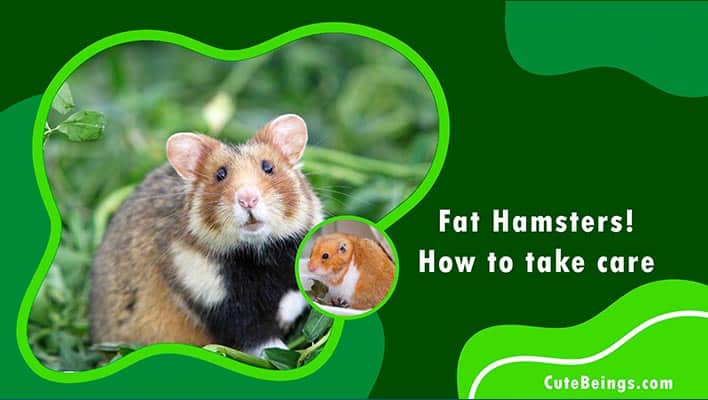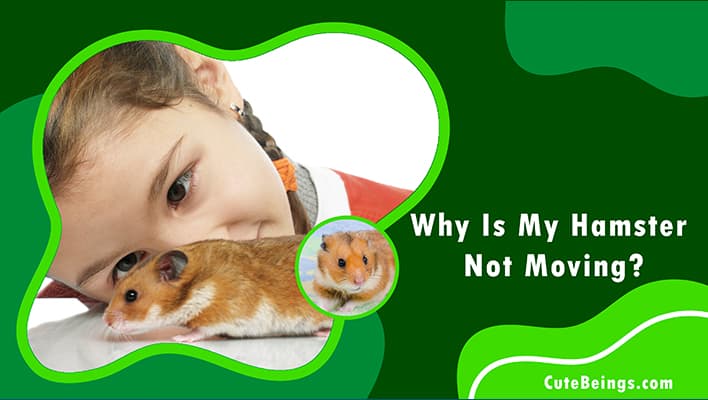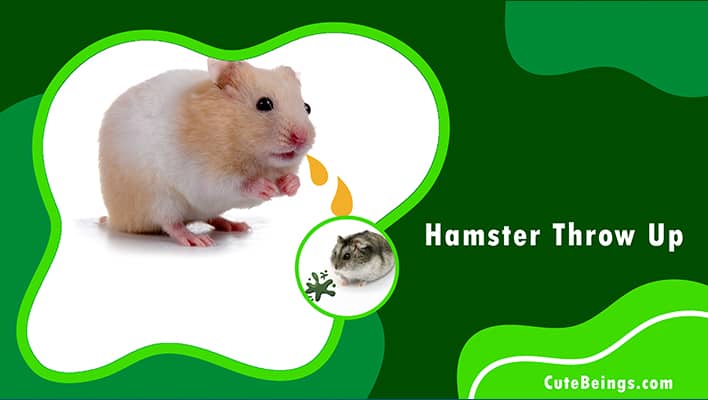Fat hamsters are a common sight and are well-known for their big-chubby appearance. So it can be hard to tell if yours is too fat or if that’s how they should look. If your hamster eats well and gets a lot of exercises, it is very unlikely to be too fat. All hamsters need proper nutrition to stay healthy. Some people overfeed their hamsters or keep them inside cages without enough exercise. Hence, this leads to a feeble fat hamster.
The most effective strategies for preventing them from gaining an unhealthy amount of weight are to ensure that they engage in appropriate physical activity on a regular basis and to make them eat a healthy, well-balanced diet. Your little one will develop better health in direct proportion to your level of concern for its wellbeing. Here’s a comprehensive guide to fat hamsters, including the facts you need to know and the steps you should take.
Table of Contents
Why is My Hamster So Fat?
Too much of Fatty foods
Your hamster will quickly gain weight if you feed it foods high in calories, fat, and protein. On the other hand, obesity can be caused by overfeeding them and increasing the amount of food they eat, such as cereals, nuts, boiled eggs, chicken, or mealworms. Remember, once or twice a week for meat snacks is really sufficient. Cheese or peanut butter is another fantastic source of vitamin-giver, but be careful not to overfeed.
Overfeeding and improper intervals within
Hamsters are omnivores and consistently decent eaters. Underweight hamsters may annoy you, but it’s also not good for their health for them to be overweight. Fat hamsters are the result of excessive feeding and overconsumption of food. Young hamsters should consume 11 to 14 grams of food per day on average. It can differ according to age and climate.
Feed your hamster only once a day so that you can get used to the routine of when and how much to feed it. Because of this, it will not expect much more or any less. So, after a few meals, its digestive system will become accustomed to the eating patterns and have a healthy flow. There should never be more than two servings each day, and a reasonable amount of time should elapse between meals.
Less exercise
Fat hamsters are ones with fewer exercises. They tend to eat and sleep a lot, which makes them gain weight every day. If you do not take these chubby, cheeky animals outside of their cage or allow them onto the playground premises, they will become lazy. Make sure you give yourself at least an hour each day to play with your pet hamster. This will keep the hamster healthy, active, and happy.
Fewer vet checkups
When you have a pet, it is in your best interest to have a close relationship with a vet. This is due to the fact that you can have access to quick and trustable remedies for your pet’s abnormal eating styles or behavioral patterns. As well, a veterinary professional will be able to estimate your hamster’s ideal body weight by taking into account the animal’s breed and age. Here, fat hamsters are heavily supported. No good will come from a lack of regular vet checkups and disregard of their guidelines.
Follow wrong routines
From pups to adults, hamsters of all ages should be introduced to healthy feeding and workout habits. In a sense, pet care will get easier for the owner. If the morning meal is served, schedule it. Always use a dish so hamsters don’t hoard. After each meal, make sure they drink enough water. In addition to that, at pet stores, you can often find pre-mixed hamster food that tries to meet many of your hamster’s nutritional needs at once. Beware, the cheapest pet food brands often contain low-quality components. So, read labels before buying. It’s better to have a menu plan.
Signs of Fat Hamsters: In a Nutshell
The average weight of a fully grown hamster is 85–150 g. Gaining extra weight in considerably large amounts can eventually lead to obesity.
Fat hamsters have cheeky pouches. Simply give your pet a treat and carefully hoist it up to examine its body. Lean, flat shapes are fine. But if you see plumpness or circular lines instead of straight ones, it’s time for a hamster diet. Moreover, fat hamsters rarely stroll or use their exercise wheels. It’s a good idea to take your hamster to the vet at this stage for a checkup.
Pregnant fat hamsters
Hamster mothers have put on weight, with a big tummy. She appears to be eating more and making her own nest can be clearly visible.
The appearance, however, is significantly different from that of a chubby hamster. A chubby hamster has a perfectly spherical body.
Tips to Slim Down Your Hamster.
Many activities can be done at home to help slim down your pet’s body weight. One can also seek advice from a veterinarian if necessary.
Do not overfeed.
Most hamsters need only a spoonful of high-quality food daily. Therefore, how much food you feed your pet, how often you feed them, and what you serve them for each meal should all be closely monitored on a daily basis.
Do you know that a hamster needs a minimum of 16 percent protein and a maximum of 5 percent fat in its diet every day? If you truly care about your pet, don’t go beyond the limit and support to aid in its long-term well-being and survival.
Create a fun and comfortable environment.
If a hamster is removed from its normal habitat and placed in a confined cage with few exercise alternatives, it will certainly gain weight. Fat hamsters must exercise for at least 20-30 minutes per day to burn calories. So, include wood chews, cardboard tubes, hamster wheels and balls, climbing and housing options, or plastic toys in their playground. At the same time, prepare a bigger cage with enough space for them to move about.
Have proper feeding practices.
Pick out some hamster food that’s of high quality. Also, you will have a better chance of keeping track of how much food your hamster consumes if you place the food in a dish. Secondly, you need to throw away any food that has been leftover from the previous day and replace it with new food each day.
Vet care in times of need.
Your fat hamster will undergo an examination by your veterinarian, who will also take note of its weight and have a conversation with you about the ideal habitat, diet, and playthings for your pet.
Diet Plan for Fat Hamsters
Some hamsters have a huge appetite, while others seem to be on a limited diet. Some are unable to control their hunger, while others have more self-control around eating. Aside from what you feed your hamster and how much, or how active he is, it really depends on his personality. It is your duty to make it a habit to feed your hamster veggies and dry grains rather than high-fat foods.
These provide abundant natural vitamins and iron for their bodies. Eggs can be roasted, hard-boiled, soft boiled, scrambled, and served to your hamster. A small amount of boiled egg yolk goes with some fruits or vegetables if two meals are served in a day.
Fat hamsters should avoid too much sugar, cheese, or peanut butter.
Water assists in the digesting process and avoids dehydration in hamsters. Thus, provide plenty of fresh, clean water.
What is the Fattest Hamster Type?
Syrian hamsters, sometimes called teddy bears or golden hamsters, are the largest domestic hamster breed. They weigh 100- 150 g and some in between 175-225 g. Syrian hamsters grow to 6 or 7 inches, double the size of dwarf hamsters.
Conclusion: Be Aware of the Hamster’s Health.
Fat hamsters are cute and cuddly. However, if the hamster’s body mass continues to rise at an undesirable rate, it may become obese, which can be upsetting to you. Most importantly, watch out for dietary intake, frequency of feeding, and nutritional composition. In case of any change in your little one, be attentive to their health for a few days and look for reliable advice and tips from qualified professionals.

Hello, my name is Michelle and I’m a pet lover. For the past 12 years, I’ve been caring for pets. As a result of this, I decided to share my personal experience with you.




